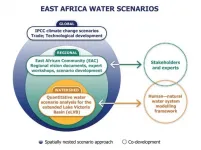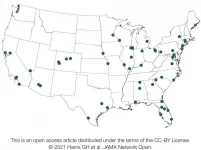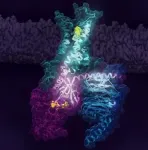(Press-News.org) IIASA researchers worked with local stakeholders from the East African Community to explore and co-develop regional water scenarios that can enhance understanding of the up- and downstream water sector interactions in the extended Lake Victoria Basin to facilitate rational water resource planning.
East Africa is the world's fastest growing region outside of Asia, with an estimated growth of 5% and above over the last decade. Part of this success can likely be attributed to the East Africa Vision 2050, which was launched in 2015 by the Heads of States of the East African Community (EAC) - an intergovernmental organization composed of six countries in the African Great Lakes region in eastern Africa. If the region's rapid development were to continue in a sustainable manner, it will have beneficial impacts for the entire African continent. The region's dynamic socioeconomic development - which is characterized by rapid economic and population growth, along with a growing rate of urbanization - will lead to increased water demand and put pressure on water quality. As the water sector is a lever for development, understanding the up- and downstream linkages in hydrological processes and human water use is essential for water resources planning in river basins.
To contribute to and facilitate such understanding, IIASA researchers undertook a quantitative modeling analysis for the transboundary headwaters of the Nile - the extended Lake Victoria Basin, which incorporates parts of seven countries and the basins of all inflows into Lake Victoria, as well as the basins of the Victoria and Albert Niles. Guided by the basin approach (a key principle in integrated water-resource management) the researchers worked with local stakeholders from the EAC and the Lake Victoria Basin Commission to explore and co-develop regional water scenarios that could be used to explore possible development pathways up to 2050 against the background of uncertain futures. Co-development of scenarios such as the researchers undertook in this study are rare, as is the combined modeling of socioeconomic and biophysical (climate change, land use change, and environmental constraints) aspects, which makes the contribution of this novel work quite significant.
"Together with local stakeholders, we assessed upstream and downstream water sector interactions in the extended Lake Victoria Basin to determine the best approach for rational water resource planning," explains Sylvia Tramberend, a researcher with the IIASA Water Security Research Group and first author of the study published in the journal One Earth. "Scenarios are an essential part of sustainability research as they help make the long-term consequences of near-term decisions understandable. In this case, the scenarios we co-developed in close collaboration with stakeholders in East Africa, aids in the identification of sustainable water-development pathways to leverage development opportunities and contribute to development. By using scenarios to portray alternative plausible development pathways, we can pursue sustainable, long-term water security."
The study's scenario assessments suggest that water use and withdrawal will increase significantly (at least fourfold) due to population and GDP growth, coupled with ambitions to significantly increase irrigation for agricultural purposes, which is currently almost non-existent in the region. Furthermore, climate change is likely to increase variability, marked by a seasonal shift in rainfall and more pronounced dry and wet periods, although this scenario is subject to a high degree of uncertainty. In addition, respecting environmental flow requirements - in other words, making sure that enough freshwater is retained in rivers and lakes throughout the year to sustain water ecosystem services - will require a significant proportion of water infrastructure in the region to rely on advanced technologies to ensure efficient water use, which are often more costly.
In light of the above, the researchers urge that the ongoing regional integration of East Africa requires that harmonization of water policy be a priority in the urgently needed development of water infrastructure, which makes interconnected analyses over time and guided by co-developed scenarios, indispensable for planning sustainable water-development pathways. The analyses of water systems must bridge the gap from the local to the regional and global scales, making cooperation and co-development of strategies and approaches to achieve this critical. Although there are still many challenges that need to be overcome in this regard, the researchers point out that the co-development of scenario narratives worked reasonably well. They however note that significantly more resources are needed to achieve true co-development between modeling exercises, which usually require input from experts and researchers, while also taking into account what stakeholders need.
"Water is a pivotal sector for sustainable development and requires smart investment strategies. Similarly important is that we foster co-development initiatives and analyses that respect both upstream and downstream interactions. This requires institutions whose mandate covers entire watersheds like the Lake Victoria Basin Commission who we worked closely with on this assessment. Strengthening these institutions is critical for water security enabled by effective implementation of sustainable development pathways," concludes Hilda Luoga, Projects Development Officer with the East African Community in the Lake Victoria Basin Commission.
INFORMATION:
Reference
Tramberend, S., Burtscher, R., Burek, P., Kahil, T., Fischer, G., Mochizuki, J., Greve, P., Kimwaga, R., et al. (2021). Co-development of East African regional water scenarios for 2050. One Earth DOI: 10.1016/j.oneear.2021.02.012
Contacts:
Researcher contact
Sylvia Tramberend
Research Scholar
Water Security Research Group
Biodiversity and Natural Resources Program
Tel: +43 2236 807 401
trambers@iiasa.ac.at
Press Officer
Ansa Heyl
IIASA Press Office
Tel: +43 2236 807 574
Mob: +43 676 83 807 574
heyl@iiasa.ac.at
About IIASA:
The International Institute for Applied Systems Analysis (IIASA) is an international scientific institute that conducts research into the critical issues of global environmental, economic, technological, and social change that we face in the twenty-first century. Our findings provide valuable options to policymakers to shape the future of our changing world. IIASA is independent and funded by prestigious research funding agencies in Africa, the Americas, Asia, and Europe.
http://www.iiasa.ac.at
PITTSBURGH, March 19, 2021 - A University of Pittsburgh School of Medicine-led survey of dozens of surge capacity managers at hospitals nationwide captures the U.S. health care system's pandemic preparedness status in the months before the first COVID-19 cases were identified in China.
Published today in the journal JAMA Network Open, the investigation details the strain experienced by U.S. hospitals during the 2017-18 influenza season, which was marked by severe illness and the highest infectious disease-related hospitalization rates in at least a decade. At the time, pandemic planning ...
A new research study at the University of Chicago Medicine has found that when it comes to COVID-19, having vitamin D levels above those traditionally considered sufficient may lower the risk of infection, especially for Black people.
The study, published March 19 in JAMA Open Network, retrospectively examined the relationship between vitamin D levels and likelihood of testing positive for COVID-19. While levels of 30 ng/ml or more are usually considered "sufficient," the authors found that Black individuals who had levels of 30 to 40 ng/ml had a 2.64 times higher risk of testing ...
What The Study Did: This analysis examined how patients with multiple sclerosis who have COVID-19 fare and what patient and disease characteristics are associated with worse outcomes.
Authors: Amber Salter, Ph.D., of Washington University in St Louis, is the corresponding author.
To access the embargoed study: Visit our For The Media website at this link https://media.jamanetwork.com/
(doi:10.1001/jamaneurol.2021.0688)
Editor's Note: The article includes conflict of interest and funding/support disclosures. Please see the article for additional information, including other authors, author contributions and affiliations, conflict of interest and financial disclosures, ...
What The Study Did: Researchers examined if differences in vitamin D levels greater than levels traditionally considered sufficient (30 ng/mL) are associated with having test results positive for COVID-19 in White and in Black individuals.
Authors: David O. Meltzer, M.D., Ph.D., of the University of Chicago, is the corresponding author.
To access the embargoed study: Visit our For The Media website at this link https://media.jamanetwork.com/
(doi:10.1001/jamanetworkopen.2021.4117)
Editor's Note: The article includes funding/support disclosures. Please see the article ...
A multinational research team led by Dr. Adnan Sljoka (RIKEN), Prof. R. Scott Prosser (Univ. of Toronto) with collaborations with Dr. Duy Phuoc Tran and Prof. Akio Kitao (Tokyo Tech) and Prof. Roger K. Sunahara (Univ. of California San Diego) has carried out experimental and computational studies, revealing key steps associated with the activation of the human adenosine A2A receptor (A2AR). A2AR is a member of superfamily of receptors called G protein-coupled receptors (GPCRs) (major drug targets) which engage the G protein and initiates cell signaling. The research team discovered that A2AR is represented by at least two inactive conformations and three active conformations whose populations are dependent on ligands and activation ...
A team of researchers has found disrupting the interaction between cancer cells and certain immune cells is more effective at killing cancer cells than current immunotherapy treatments.
The findings, which include studies in cell lines and animal models, appeared in JCI Insight and focus on END ...
MOSCOW, RUSSIA -
Moscow Center for Diagnostics & Telemedicine and RADLogics shared the results of a large-scale study (Moscow Experiment on the Computer Vision for the Analysis of Medical Images - mosmed.ai, NCT04489992) conducted by the Research and Practical Clinical Center for Diagnostics and Telemedicine Technologies of the Moscow Health Care Department. The clinical research found that the introduction of RADLogics' AI-Powered solution into radiology workflow to analyze Chest-CT scans during the COVID-19 pandemic reduced report turnaround ...
TROY, N.Y. -- A novel form of polymerized estrogen developed at Rensselaer Polytechnic Institute can provide neuroprotection when implanted at the site of a spinal cord injury -- preventing further damage. This promising result, found in a preclinical model, was recently published in ACS Chemical Neuroscience, and it lays the groundwork for further advancement of this new biomaterial.
"What we saw that gives us hope is more neuroprotection, meaning we saw more spared neurons and more spared axons in the tissue," said Ryan Gilbert, a professor of biomedical engineering at Rensselaer, and co-author on this paper. "We believe that the estrogen released from our biomaterial design is providing a neuroprotective response."
After a spinal cord injury, the body's inflammatory ...
The results showed that several psychological well-being measures gradually increased within participants from the beginning to the end of the course. That was especially true for life satisfaction, perceived well-being, self-awareness and emotional self-regulation. The participants in the study also reported a significant decrease in anxiety, perceived stress, negative thoughts, rumination and anger tendencies. The researchers observed, simultaneously, improvements in the positive aspects and a reduction of negative emotions, both in the short term and longitudinally ...
UNIVERSITY PARK, Pa. -- Stress is a universal human experience that almost everyone deals with from time to time. But a new study found that not only do some people report feeling no stress at all, but that there may be downsides to not experiencing stress.
The researchers found that people who reported experiencing no stressors were more likely to experience better daily well-being and fewer chronic health conditions. However, they were also more likely to have lower cognitive function, as well.
David M. Almeida, professor of human development and family studies at Penn State, said the study suggests that small, daily stressors could potentially benefit the brain, despite being an inconvenience.
"It's possible that experiencing stressors creates opportunities for you ...



